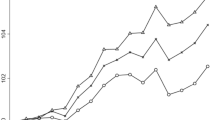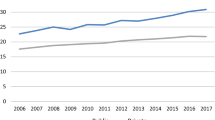Abstract
Based on Labour Force Survey data for Canada over the period 1998 to 2018, we find occupational licensing raised average real wages from 6.1% in 1998 to 13.8% by 2018, slightly less for propensity score matching estimates, suggesting the effect is somewhat lower after adjusting for unobservable factors that can affect pay. Unconditional quantile regressions indicate the licensing effects on wages are greater at the higher ends of the wage distribution, with those inequality enhancing effects becoming more pronounced over time. In contrast, the union wage premium declined steadily from 9.2% in 1998 to 5% in 2018, with a substantial premium at the bottom of the wage distribution but a steady decline at the top, becoming negative at higher parts of the wage distribution, with those equality enhancing effects becoming less pronounced over time. Overall, the estimates for Canada indicate that occupational licensing contributes to wage inequality, and the effect is increasing over time, while unions reduce overall wage inequality, but this equalizing effect is decreasing over time.

Similar content being viewed by others
References
Acemoglu D, Autor DH (2011) Skills, tasks and technologies: implications for employment and earnings. In: Ashenfelter O, Card D (eds) Handbook of labor economics, (Vol. 4B, pp. 1043–1071). North Holland, Amsterdam
Atkinson AB, Piketty T (eds) (2010) Top incomes: a global perspective. Oxford University Press, Oxford
Autor DH, Katz LF, Krueger AB (1998) Computing inequality: have computers changed the labor market? Q J Econ 113(4):1169–1213
Autor DH, Dorn D, Hanson GH (2016a) The China shock: learning from labor-market adjustment to large changes in trade. Annu Rev Econ 8(1):205–240
Autor DH, Manning A, Smith CL (2016b) The contribution of the minimum wage to US wage inequality over three decades: a reassessment. Am Econ J Appl Econ 8(1):58–99
Benjamin D, Gunderson M, Lemieux T, Riddell C (2017) Labour market economics: theory, evidence and policy in Canada, 8th edition. McGraw-Hill, Toronto
Bidwell M, Briscoe F, Fernandez-Mateo I, Sterling A (2013) The employment relationship and inequality: how and why changes in employment practices are reshaping rewards in organizations. Acad Manag Ann 7(1):61–121
Borah BJ, Basu A (2013) Highlighting differences between conditional and unconditional quantile regression approaches through an application to assess medication adherence. Health Econ 22(9):1052–1070
Budig MJ, Hodges MJ (2014) Statistical models and empirical evidence for differences in the motherhood penalty across the earnings distribution. Am Sociol Rev 79(2):358–364
Campolieti M (2018) Matching and inverse propensity weighting estimates of the union wage premium: evidence from Canada, 1997–2014. Ind Relat 57(1):101–130
Card D, DiNardo JE (2002) Skill-biased technological change and rising wage inequality: some problems and puzzles. J Labor Econ 20(4):733–783
Card D, Freeman R (1993) Small differences that matter: labor markets and income maintenance in Canada and the United States. University of Chicago Press, Chicago
Card D, Lemieux T, Riddell CW (2020) Unions and wage inequality: the roles of gender, skill and public sector employment. Can J Econ 53(1):130–173
Chi W, Li B (2008) Glass ceiling or sticky floor? Examining the gender earnings differential across the earnings distribution in urban China, 1987–2004. J Comp Econ 36(2):243–263
Cobb AJ (2016) How firms shape income inequality: stakeholder power, executive decision making, and the structuring of employment relationships. Acad Manag Rev 41(2):324–348
DiNardo JE, Fortin NM, Lemieux T (1996) Labor market institutions and the distribution of wages, 1973-1992: a semi-parametric approach. Econometrica 64(5):1001–1044
Firpo S, Fortin NM, Lemieux T (2009) Unconditional quantile regressions. Econ 77(3):953–973
Fortin NM, Lemieux T (1997) Institutional changes and rising wage inequality: is there a linkage? J Econ Perspect 11(2):75–96
Fortin NM, Lemieux T (2015) Changes in wage inequality in Canada: an interprovincial perspective. Canadian Journal of Economics/Revue canadienne d'économique 48(2):682–713
Fortin NM, Green DA, Lemieux T, Milligan K, Riddell CW (2012) Canadian inequality: recent developments and policy options. Can Public Policy 38(2):121–145
Foster JE, Wolfson MC (2010) Polarization and the decline of the middle class: Canada and the US. J Econ Inequal 8(2):247–273
Friedman M, Friedman R (1980) Free to choose: a personal statement. Avon Books, New York
Galor O, Moav O (2000) Ability-biased technological transition, wage inequality, and economic growth. Q J Econ 115(2):469–497
Gittleman M, Kleiner MM (2016) Wage effects of unionization and occupational licensing coverage in the United States. Ind Labor Relat Rev 69(1):142–172
Gittleman M, Klee MA, Kleiner MM (2018) Analyzing the labor market outcomes of occupational licensing. Ind Relat 57(1):57–100
Gomez R, Lamb D (2019) Unions and non-standard work: union representation and wage premiums across non-standard work arrangements in Canada, 1997–2014. Ind Labor Relat Rev 72(4):1009–1035
Gomez R, Gunderson M, Huang X, Zhang T (2015) Do immigrants gain or lose by occupational licensing? Can Public Policy 41(supplement 1):S80–S97
Guadalupe M (2007) Product market competition, returns to skill, and wage inequality. J Labor Econ 25(3):439–474
Gunderson M, Krashinsky H (2015) Returns to apprenticeship based on the 2006 Canadian census. Ind Labor Relat Rev 68(5):1078–1101
Helpman E (2018) Globalization and wage inequality. Harvard University Press, Cambridge, MA
Ingram S (2019) Occupational licensing and the earnings premium in the United States: updated evidence from the current population survey. Br J Ind Relat 57(4):732–763
Killewald A, Bearak J (2014) Is the motherhood penalty larger for low-wage women? A comment on quantile regression. Am Sociol Rev 79(2):350–357
Kim C, Sakamoto A (2008) The rise of intra-occupational wage inequality in the United States, 1983 to 2002. Am Sociol Rev 73(1):129–157
Kleiner MM (2000) Occupational licensing. J Econ Perspect 14(4):189–202
Kleiner MM (2006) Licensing occupations: ensuring quality or restricting competition? W. E. Upjohn Institute, Kalamazoo, MI
Kleiner MM, Krueger AB (2010) The prevalence and effects of occupational licensing. Br J Ind Relat 48(4):676–687
Kleiner MM, Krueger AB (2013) Analyzing the extent and influence of occupational licensing on the labor market. J Labor Econ 31(S1):S173–S202
Kleiner MM, Vorotnikov E (2017) Analyzing occupational licensing among the states. J Regul Econ 52(2):132–158
Koumenta M, Pagliero M (2019) Occupational regulation in the European Union: coverage and wage effects. Br J Ind Relat 57(4):818–849
Lemieux T (2008) The changing nature of wage inequality. J Popul Econ 21(1):21–48
Lindqvist E, Vestman R (2011) The labor market returns to cognitive and non-cognitive ability: evidence from the Swedish enlistment. Am Econ J Appl Econ 3(1):101–128
Mullen B, Brown R, Smith C (1992) In-group bias as a function of salience, relevance and status: an integration. Eur J Soc Psychol 22(2):103–122
Piketty T, Saez E (2017) Income inequality in the United States, 1913–2010. Q J Econ 118(1) 2003:1–39
Pizzola B, Tabarrok A (2017) Occupational licensing causes a wage premium: Evidence from a natural experiment in Colorado’s funeral services industry. Int Rev Law Econ 50(C):50–59
Riaz S (2015) Bringing inequality back in: the economic inequality footprint of management and organizational practices. Hum Relat 68(7):1085–1097
Salverda W, Checchi D (2015) Labour market institutions and the dispersion of wage earnings. In: Atkinson T, Bourgignon F (eds) Handbook of income distribution, vol 2B. North Holland, Amsterdam, pp 1535–1727
Sørensen AB (1996) The structural basis of social inequality. Am J Sociol 101(5):1333–1365
Tajfel H, Turner JC (1979) An integrative theory of intergroup conflict. Organizational identity: a reader, 56, 65. In: Austin W, Worchel SS (eds) The social psychology of intergroup relations. Brooks/Cole, Monterey, pp 33–47
Timmons E, Thornton R (2019) There and back again: the de-licensing and re-licensing of barbers in Alabama. Br J Ind Relat 57(4):764–790
Weeden KA (2002) Why do some occupations pay more than others? Social closure and earnings inequality in the United States. Am J Sociol 108(1):55–101
Weeden KA, Grusky DB (2014) Inequality and market failure. Am Behav Sci 58(3):473–491
Weeden KA, Kim Y, Di Carlo M, Grusky DB (2007) Social class and earnings inequality. Am Behav Sci 50(5):702–736
Zhang T (2019) Effects of occupational licensing and unions on labour market earnings in Canada. Br J Ind Relat 57(4):791–817
Author information
Authors and Affiliations
Corresponding author
Ethics declarations
Conflict of Interest
The authors declare that they have no conflict of interest.
Additional information
Publisher’s Note
Springer Nature remains neutral with regard to jurisdictional claims in published maps and institutional affiliations.
Rights and permissions
About this article
Cite this article
Zhang, T., Gunderson, M. Impact of Occupational Licensing on Wages and Wage Inequality: Canadian Evidence 1998–2018. J Labor Res 41, 338–351 (2020). https://doi.org/10.1007/s12122-020-09310-7
Accepted:
Published:
Issue Date:
DOI: https://doi.org/10.1007/s12122-020-09310-7




